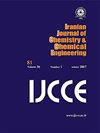The Effect of formetanate hydrochloride on the glycated human hemoglobin
IF 1.3
4区 工程技术
Q4 CHEMISTRY, MULTIDISCIPLINARY
Iranian Journal of Chemistry & Chemical Engineering-international English Edition
Pub Date : 2021-07-27
DOI:10.30492/IJCCE.2021.139876.4430
引用次数: 0
Abstract
ABSTRACTGlycation refers to the nonenzymatic glycosylation of the free amino groups of proteins and sugars. Advanced glycation end products (AGEs) is the final stage in glycation process. AGEs cause many complications in diabetic’s patients. Formetanate hydrochloride is a highly effective pesticide widely used in agriculture. Hence, all human beings, both healthy and diabetics affected patients, can be exposed to this toxin. Therefore, the purpose the present research is to study, the effect of Formetanate hydrochloride upon the glycated human hemoglobin (GHb). To form glycated hemoglobin, Hb was incubated with glucose for 35 days under physiological conditions (dark, 37Ċ and pH 7.4). The effect of the toxin on GHb was investigated via docking studies, flurometry, and UV-Vis and circular dichroism spectroscopy. Incubating Hb with glucose could degrade the structure the protein. Samples contained GHb and formetanate hydrochloride showed remarkable changes in structure; Heme-group degradation and an increase in β-sheet structures was also observed. The results of docking studies were consistent with these results. As diabetes is rapidly expanding in today's world and formetanate hydrochloride is widely used in agriculture, the impact of this toxin on these patients will be very important. According to the results obtained, this toxin can have more destructive effect on the glycated Hb in these patients.盐酸甲酸乙酯对糖化人血红蛋白的影响
糖基化是指蛋白质和糖的游离氨基的非酶糖基化。晚期糖基化终产物是糖基化过程的最后阶段。AGEs在糖尿病患者中引起许多并发症。盐酸甲甲酸酯是一种广泛应用于农业的高效农药。因此,所有人,无论是健康的还是糖尿病患者,都可能接触到这种毒素。因此,本研究的目的是研究盐酸甲酸乙酯对糖化人血红蛋白(GHb)的影响。为了形成糖化血红蛋白,Hb与葡萄糖在生理条件下(黑暗,37Ċ和pH 7.4)孵育35天。通过对接研究、荧光法、紫外可见光谱和圆二色光谱研究了毒素对GHb的影响。与葡萄糖孵育Hb可以降解蛋白质的结构。含有GHb和盐酸甲酸乙酯的样品结构发生了显著变化;血红素基团降解和β-薄片结构增加也被观察到。对接研究的结果与上述结果一致。随着糖尿病在当今世界的迅速扩大和盐酸甲酸乙酯在农业中的广泛应用,这种毒素对这些患者的影响将是非常重要的。根据所获得的结果,这种毒素对这些患者的糖化Hb具有更大的破坏性作用。
本文章由计算机程序翻译,如有差异,请以英文原文为准。
求助全文
约1分钟内获得全文
求助全文
来源期刊

Iranian Journal of Chemistry & Chemical Engineering-international English Edition
CHEMISTRY, MULTIDISCIPLINARY-ENGINEERING, CHEMICAL
CiteScore
2.80
自引率
22.20%
发文量
0
审稿时长
6-12 weeks
期刊介绍:
The aim of the Iranian Journal of Chemistry and Chemical Engineering is to foster the growth of educational, scientific and Industrial Research activities among chemists and chemical engineers and to provide a medium for mutual communication and relations between Iranian academia and the industry on the one hand, and the world the scientific community on the other.
 求助内容:
求助内容: 应助结果提醒方式:
应助结果提醒方式:


